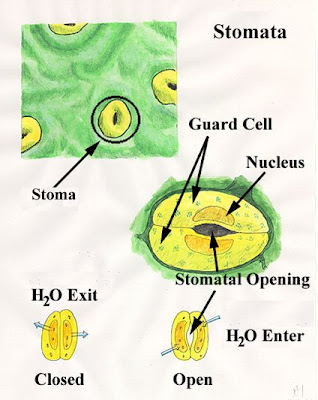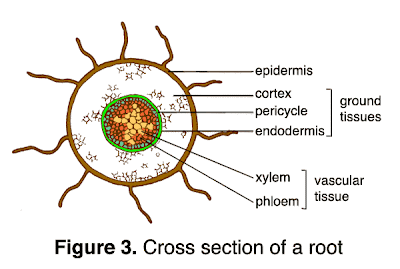 ROLE OF THE LEAF
ROLE OF THE LEAFconvert light into food= photosythesis
provide shade and camouflage for other organisms
fallen leaves provide habitat+ food for decomposers ( ex. fungi&bacteria)
add beauty to environment
EPIDERMIS 
What is an epidermis?
Secondary Structure: Cuticle
since the epidermis is not completely waterproof, the cuticle performs this job
a thin waxy covering on the top layer of leaves
blocks gases through the cells of the epidermis
Result: both the cuticle+ epidermis are transparant= allows light through the leaf
STOMATA 
What is a stomata?
Secondary Structure: Guard Cells
regulate rate of gas exchange by controlling the size of the stomata
- large opening of stomata= faster the leaf can exchange oxygen and carbon dioxide
guard cells surround the stomata and are shaped like two cupped hands= changes within water pressure causing the stoma( singular of stomata) to open or close= when guard cells are full of water they swell up and bend away from each other= opening the stoma
during dry times= the guard cells close
when guard cells swell= stomates close
when guard cells shrink= stomates open
plants respond to changes in temperature and humidity by opening or closing their stomata
in result, guard cells regulate the opening and closing of the stomata+ control the exchange of gases between the leaf and the surrounding atmosphere

SPONGY LAYER

Located beneath the palisade layer, its cells are irregular in shape and loosely packed. Although they contain a few chloroplasts, their main function is the temporary storage of sugars and amino acids synthesized in the palisade layer. They also help in the exchange of gases between the leaf and the environment. During the day, these cells give off oxygen and water vapor to the air spaces that surround them. They also pick up carbon dioxide from the air spaces. The air spaces are interconnected and open to the outside through the stomata (singular stoma).
VASCULAR TISSUE

What is a vascular tissue?
found in the veins of a leaf which consists of xylem ( transports water& minerals from roots-->stem--->leaves) & phloem ( transports sugar/food)
veins conduct water & dissolved minerals in and out of the leaf
Veins in a leaf perform 3 fluid- conducting functions
conduct water into the leaf
conduct dissolved minerals into the leaf
conduct dissolved carbohydrates ( nutrients) out of the leaf
Secondary Structures
PALISADE CELLS























